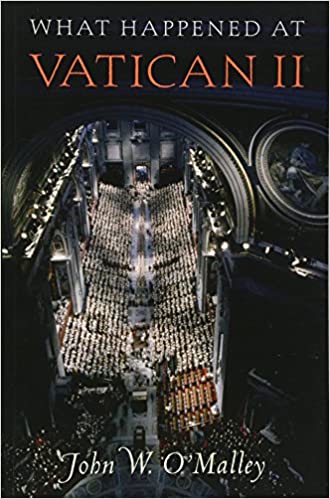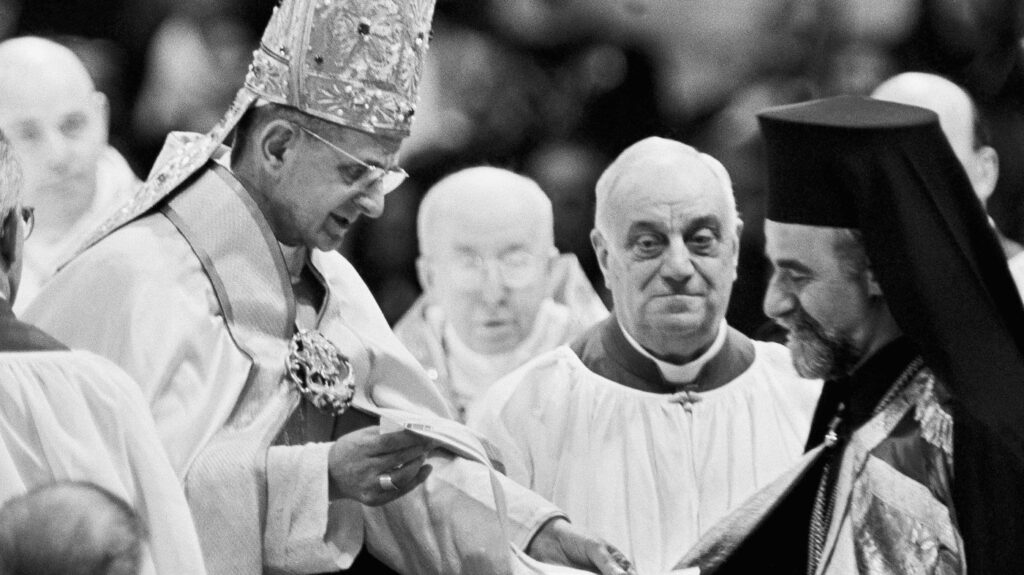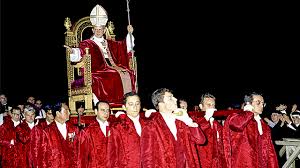I recently plowed through Fr. John O’Malley’s large book What Happened at Vatican II? The word plowed is the operative word. The 380 page tome is a serious, scholarly, systematic overview of the Council, “the biggest meeting in the history of the world.” It took me three months of “off-and-on-again reading” to finish the book. Why did I persevere? Because the book was not only highly readable, it was also very, very interesting! Let me share a few facts/quotes from this book.
1. When the Council was convoked by Pope John XXIII, some bishops hoped it would be a one-session conclave of several weeks. Instead, the Council, including the preliminary and follow-up work, extended over four years! The actual four sessions began on October 11, 1962 and ended on December 8, 1965. An average of 2,860 bishops attended part or all of the four sessions. Vatican I, in contrast, had 750 bishops. In addition, there were periti (theology experts), secretaries, journalists, and between 50-100 “observers and guests.” The meetings were held in the nave of St. Peter’s Basilica. Despite its huge size (over 26,000 square feet), “it was barely sufficient to hold all the attendees.” (p. 23)

2. The Council consisted essentially of clerics, although a few laymen were invited as “auditors.” By the third session, 21 laymen were present and three of them actually addressed the Council. At this session, the first women were also invited as auditors, 7 laywomen and 8 women from different religious congregations. But no woman ever spoke at the Council.
3. O’Malley vividly describes the heated discussions and disagreements among the Council fathers in areas such as the Church’s attitude toward the world, the Church’s place in the world, the relationship of scripture and tradition, ecumenism, religious liberty, papal authority, collegiality of bishops, the style and tone of the documents, to name a few. It was fascinating to hear both (or more!) sides to certain “hot button” issues. And it was amazing that consensus was eventually reached on so many of these issues. But not all, of course. For example, in the middle of the Council, Pope Paul VI took four topics off the table: birth control, celibacy, the reform of the Curia, and the mechanism to implement collegiality of the bishops.
4. Throughout the book, O’Malley shuns away from speaking of “liberals” and “conservatives.” Instead he uses the terms “majority” and “minority.” He says the so-called liberals “argued that their positions were more conservative than those of the conservatives because they were retrievals of traditions fundamental and ancient.” (p. 292)
5. The Council made clear that the Church “is in the modern world—not above it, not below it, not for it, not against it. Therefore, like everybody else in the world, the Church must assume its share of responsibility for the well-being of the world, not simply denounce what it finds wrong.” (p. 297)

6. O’Malley calls Vatican II “a language event.” He shows how the radical change in language from previous councils gave us a new vision of Catholicism. The Church went “from commands to invitations, from laws to ideals, from definition to mystery, from threats to persuasion, from coercion to conscience, from monologue to dialogue, from ruling to serving, from withdrawn to integrated, from vertical to horizontal, from exclusion to inclusion, from hostility to friendship, from rivalry to partnership, from suspicion to trust, from acceptance to active engagement, from fault-finding to appreciation, from prescriptive to principled, from behavior modification to inner appropriation.” (p. 307)
7. O’Malley makes some of the key figures of the Council come alive. For example, he contrasts Cardinal Alfredo Ottaviani, head of the most powerful body in the Roman Curia, with Cardinal Augustin Bea, a German Jesuit who was on “the cutting edge” of the latest scripture scholarship coming from the Protestant churches in Germany. Ottaviani, born into a poor family in Rome, spent most of his career in the Curia. He was “intelligent, shrewd, witty, and of unquestioned moral integrity.” Even while a Cardinal, he maintained an active ministry with the young people in Rome. The motto on his coat of arms was Semper Idem, “always the same.” O’Malley adds, “he was not used to having his authority challenged.” (p. 108)

In contrast, Bea’s experience was much broader. He had served as provincial superior for the Jesuits of Bavaria. He also studied Eastern philology in Protestant Prussia. In 1924 he began his career teaching at the Biblicum. O’Malley writes, “In his person he radiated an inner serenity that made him approachable and easy to converse with. It also generated respect for his opinions.” Bea, more than any other person, shepherded the Council through three of the most difficult and highly contested documents—on the Jews, on Religious Liberty, and on Divine Revelation. (p. 110)
8. “The sixteen final documents of the council… ran to over 300 pages… the documents of the Council of Trent (ran) to about 130 pages, and the documents of those two councils together almost equal the documents of the other 19 councils put together.” (p. 25)
I’ll conclude with these words by Peter Steinfels in the New York Times: “Father O’Malley has written one of the best and most needed books about the Second Vatican Council…. (it) is a story of bold confrontations, clashing personalities and behind-the-scenes maneuvers, all recounted in colorful detail…with plenty of cliffhangers.”
For reflection:
Did anything in this reflection stand out for you? If so, why?
Are you old enough to remember the Catholic Church before Vatican II? If so, what do you remember about it? Is there anything you miss? Anything you’re glad was changed?
What impact (if any) have the documents of Vatican II had on your personal spiritual life?
PS: I want to thank the Sisters of St. Joseph in Watertown, NY for their prayerful Zoom retreat. I am especially grateful to Sister Eamon for inviting me back to Watertown to facilitate this retreat and for playing my song/videos throughout the week. She was a great DJ! And thank you, my Sunflower community, for your prayers!
Vatican II had a tremendous impact on liturgy. Here’s a song that was obviously written post Vatican II, “God Has Chosen Me” by Bernadette Farrell. First it uses only a drum for accompaniment—no organ. Its refrain is “God has chosen ME,” thus highlighting each Christian’s personal vocation. Each of us (not just the clergy) is called “to give birth to a new Kingdom on earth,” by removing oppression…raising our voice “with those who have no power or choice.”
Thanks again for reading my blog!






